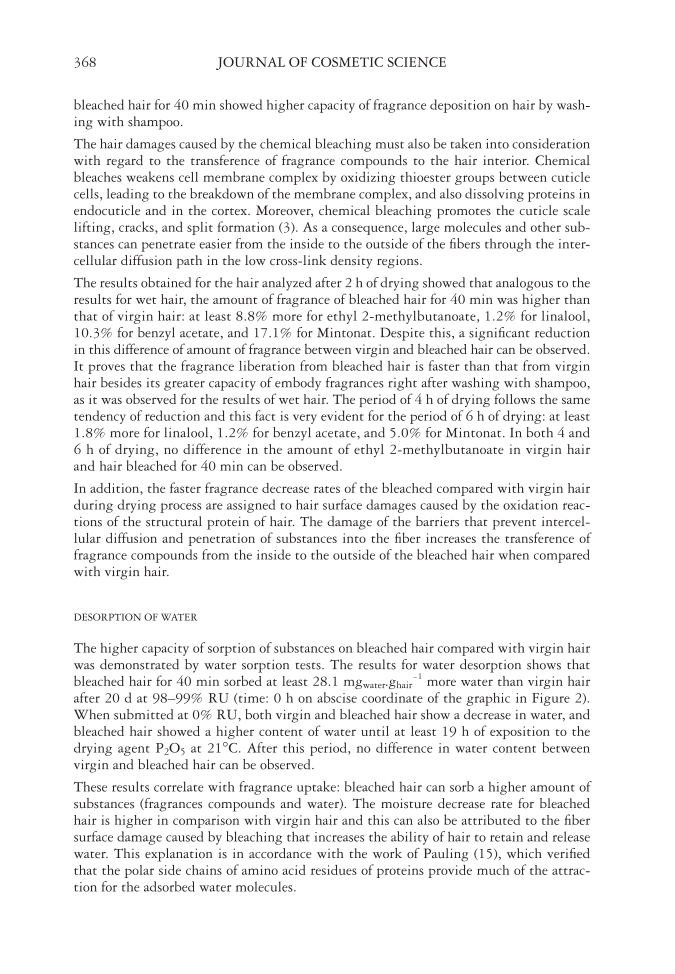JOURNAL OF COSMETIC SCIENCE 368 bleached hair for 40 min showed higher capacity of fragrance deposition on hair by wash- ing with shampoo. The hair damages caused by the chemical bleaching must also be taken into consideration with regard to the transference of fragrance compounds to the hair interior. Chemical bleaches weakens cell membrane complex by oxidizing thioester groups between cuticle cells, leading to the breakdown of the membrane complex, and also dissolving proteins in endocuticle and in the cortex. Moreover, chemical bleaching promotes the cuticle scale lifting, cracks, and split formation (3). As a consequence, large molecules and other sub- stances can penetrate easier from the inside to the outside of the fi bers through the inter- cellular diffusion path in the low cross-link density regions. The results obtained for the hair analyzed after 2 h of drying showed that analogous to the results for wet hair, the amount of fragrance of bleached hair for 40 min was higher than that of virgin hair: at least 8.8% more for ethyl 2-methylbutanoate, 1.2% for linalool, 10.3% for benzyl acetate, and 17.1% for Mintonat. Despite this, a signifi cant reduction in this difference of amount of fragrance between virgin and bleached hair can be observed. It proves that the fragrance liberation from bleached hair is faster than that from virgin hair besides its greater capacity of embody fragrances right after washing with shampoo, as it was observed for the results of wet hair. The period of 4 h of drying follows the same tendency of reduction and this fact is very evident for the period of 6 h of drying: at least 1.8% more for linalool, 1.2% for benzyl acetate, and 5.0% for Mintonat. In both 4 and 6 h of drying, no difference in the amount of ethyl 2-methylbutanoate in virgin hair and hair bleached for 40 min can be observed. In addition, the faster fragrance decrease rates of the bleached compared with virgin hair during drying process are assigned to hair surface damages caused by the oxidation reac- tions of the structural protein of hair. The damage of the barriers that prevent intercel- lular diffusion and penetration of substances into the fi ber increases the transference of fragrance compounds from the inside to the outside of the bleached hair when compared with virgin hair. DESORPTION OF WATER The higher capacity of sorption of substances on bleached hair compared with virgin hair was demonstrated by water sorption tests. The results for water desorption shows that bleached hair for 40 min sorbed at least 28.1 mgwater.ghair-1 more water than virgin hair after 20 d at 98–99% RU (time: 0 h on abscise coordinate of the graphic in Figure 2). When submitted at 0% RU, both virgin and bleached hair show a decrease in water, and bleached hair showed a higher content of water until at least 19 h of exposition to the drying agent P2O5 at 21°C. After this period, no difference in water content between virgin and bleached hair can be observed. These results correlate with fragrance uptake: bleached hair can sorb a higher amount of substances (fragrances compounds and water). The moisture decrease rate for bleached hair is higher in comparison with virgin hair and this can also be attributed to the fi ber surface damage caused by bleaching that increases the ability of hair to retain and release water. This explanation is in accordance with the work of Pauling (15), which verifi ed that the polar side chains of amino acid residues of proteins provide much of the attrac- tion for the adsorbed water molecules.
FRAGRANCE RETENTION IN HAIR 369 CONCLUSIONS The results presented herein indicate that bleaching process provokes deep damage in hair structures, altering its properties of interaction with materials. Fragrance deposition by washing with shampoo is greater on bleached hair in than on virgin hair (at least 40.0% more abundance for ethyl 2-methylbutanoate, 16.9% for linalool, 20.2% for benzyl acetate, and 24.6% for Mintonat). This behavior was attributed to the increase of interac- tion surface after hole formation in the cortex with dissolution of melanin granules, to the damage in hair structure that increased both intercellular and transcellular diffusion, and to the increase of affi nity between hair fi ber and fragrance compounds with the increase of the polar character of hair after the oxidation of cysteine groups. This last observation is in accordance with the results obtained for the deposition of rhodamine B on hair. Nev- ertheless, the amount of fragrance materials decreases faster in bleached hair, and this behavior also attributed to the diffusion increase caused by damages in hair structure after chemical bleaching. The results observed for the interaction of fragrance with hair are in accordance with the results obtained for the moisture desorption that was at least 28.1 mgwater.ghair-1 greater on bleached hair but showed no difference after 19 h at RU 0% in comparison with virgin hair. ACKNOWLEDGMENTS AJM is thankful to Fundação de Amparo à Pesquisa do Estado de São Paulo for fi nancial sup- port (grant 2014/50249-9 and 2018/07978-0) and to CNPq (grant 309885/2013-5). André Medice is thankful for the Symrise scholarship. Figure 2. Water desorption from virgin (red fi lled circle) and bleached hair for 40 min (black fi lled square) as a function of period of drying (RU 0%, at 21°C).
Purchased for the exclusive use of nofirst nolast (unknown) From: SCC Media Library & Resource Center (library.scconline.org)









































































































